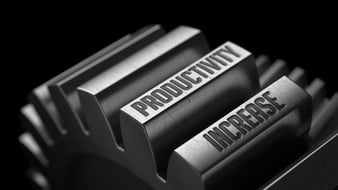 For many modern economies, maintaining productivity is a major issue. Keeping productivity high helps keep businesses going strong so they can add new jobs.
For many modern economies, maintaining productivity is a major issue. Keeping productivity high helps keep businesses going strong so they can add new jobs.
In a recent FT.com article, Marlin Steel was mentioned as an example of improved productivity in American manufacturing. However, while Marlin Steel used production automation to “boost employee productivity fourfold since 1998,” these efficiency gains “are not being replicated across America,” according to the article.
Why is productivity so important to the American economy? What are some of the obstacles to improving productivity?
In many ways, productivity is the secret to building a strong American economy. Here are a few ways in which improving productivity helps the American economy:
It Helps Make Goods Affordable
With consistently growing productivity comes affordable goods, stimulating the sale of said goods by making them easier for members of the middle class to afford.
The more productive a manufacturer is, the less capital that manufacturer has to spend on labor per item made. This helps to drive down costs and increase supply. The end result is a more affordable product for the mass market.
When these cost savings are applied to basic necessities, middle class families will have more money available to spend on other things, such as luxuries, stimulating the economy with discretionary spending.
It Allows for an Improved Quality of Life for Americans
When the prices for basic necessities go down, it becomes easier for mid-to-low income families to fulfill those basic necessities. This, in turn, leads to an overall improved quality of life for the average American.
Productive Companies Add Jobs, Growing the Taxpayer Base
As productive companies sell more goods and demand increases, they will frequently add new jobs to increase their production to meet demand. This adds more jobs to the economy, and helps to grow the taxpayer base.
With more earners, there are more people buying basic necessities and contributing to the nation’s economy. This also helps move off of welfare programs and create new tax revenue for the government.
Challenges to Increasing Productivity
 The benefits of improved productivity for the economy are numerous, but so too are the obstacles between manufacturers and productivity improvements.
The benefits of improved productivity for the economy are numerous, but so too are the obstacles between manufacturers and productivity improvements.
Some of these challenges include:
- Lack of investment in manufacturing infrastructure. For a long time, the American economy was in a state of recession, and many companies sought to offshore their production to overseas locations. This led these companies to stop making investments in updating their American factory locations.
- New technologies are having a smaller impact on productivity compared to previous innovations. The early 20th century was a time of massive change for manufacturers. In a few short years, the whole philosophy of how production would be handled changed. In the FT.com article, it is stated that “since the 1970s we have failed to match the productivity-transforming inventions created earlier in the 20th century.” In short, it is being said that the vast majority of productivity improvements that can be made have already been made, so there is less room for drastic growth.
- Predetermined productivity ceilings. Another argument seen in the FT.com article is that “parts of the services sector have fundamental limits on productivity.” In other words, some industries can only be so efficient, so there is no room for improvements to their productivity.
Despite these issues, there is almost always room for improvement in productivity.
For example, the lack of investment in manufacturing infrastructure is an issue that many manufacturers such as Marlin Steel have already dealt with over the years.
Since 1998, Marlin Steel has invested heavily in the use of manufacturing automation, and the practice has paid off massively in terms of productivity improvements. Since adding factory automation, Marlin Steel’s productivity has increased 400%, allowing the company to add jobs, grow, and thrive in the face of direct foreign competition.
With a strong investment in factory automation, American manufacturers can build an enormous edge over foreign competitors in terms of productivity per worker.
As for the argument that new tech is having a less dramatic influence on productivity than previous innovations had, that may well be true. However, there are always new techniques and technologies being added to the list of tools available to manufacturers, and every improvement, no matter how small, can make a difference.
By constantly working to find new ways to improve productivity and overcome the challenges that may be in the way, manufacturers can help to drive the American economy forward and stay competitive on a global scale.
Discover more about how Marlin Steel can help your company be more productive and competitive today by contacting us here.



.gif)


